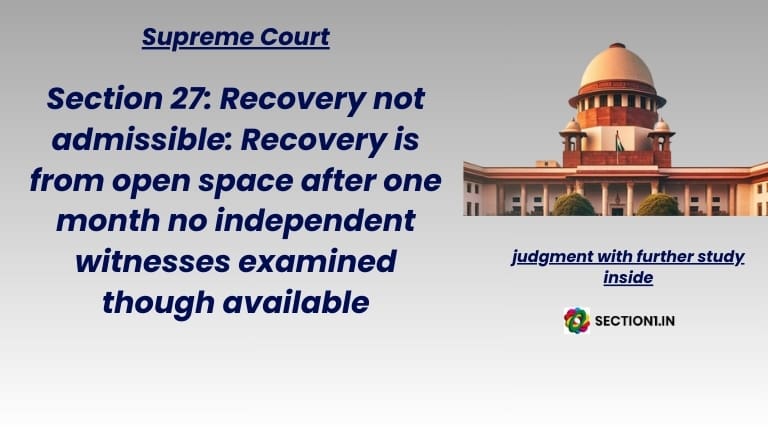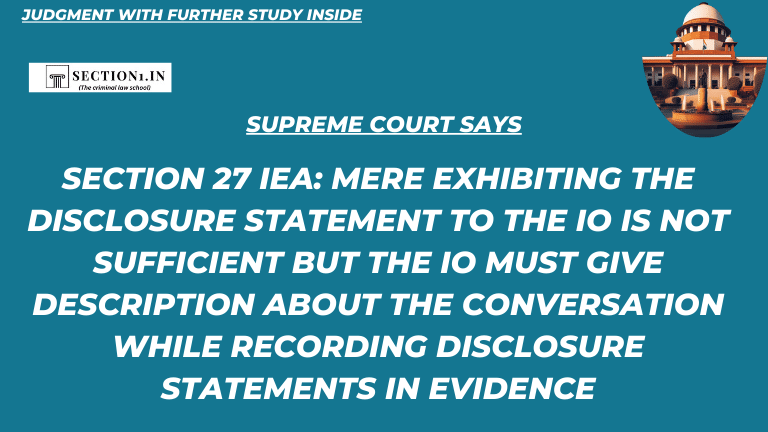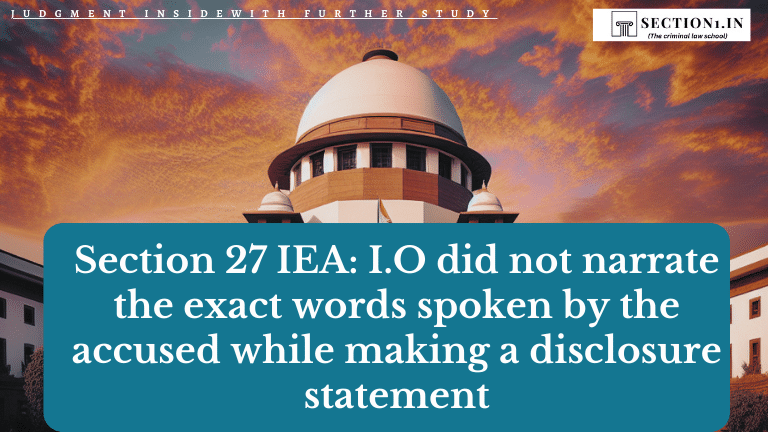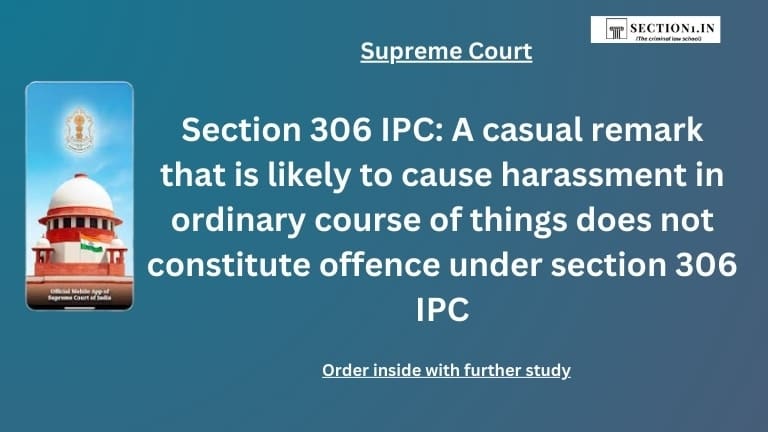Challenge
The appellant is accused no.2, who, along with accused no.1 – Mahesh, was convicted for the offences punishable under Section 302 of the Indian Penal Code (for short ‘IPC’) and Section 25 of the Arms Act. The appellant and the co-accused were ordered to undergo life imprisonment for the offence punishable under Section 302 of the IPC. The conviction and sentence of the appellant have been confirmed by the High Court by the impugned judgment.
Case and trial
2.It is a case of the murder of Pawan and Ajju Chaudhary. According to the prosecution case, on 03rd of January 2004, the deceased Pawan went to Rohini to meet his ailing sister Sushila. Dharmender (PW-2) is the complainant. Dharmender is the brother of the deceased Pawan. According to Dharmender, the deceased Pawan had fallen into bad company and cases of dacoity and theft were registered against him. He stated that on 04th January 2004, he enquired with his sister, who told him that the deceased Pawan had returned after meeting her. According to Dharmender, around 09:00 a.m. on 05th January 2004, he was informed by someone that his brother Pawan had been shot dead. Thereafter, the bodies of both the deceased were found by the police.
3.The prosecution examined a total of 20 witnesses. The prosecution relied upon the evidence of PW-1 – Mukesh and PW-3 – Vijender as they were allegedly the eyewitnesses. Dharmender (PW-2) was also examined. The other two material witnesses are PW-15 Sub-inspector Desh Raj and PW-20 DSP Puran Chand. At the relevant time, PW-20 was the Investigating Officer. Both the witnesses are relevant on the issue of recovery of the weapon of the offence at the appellant’s instance, as there are no independent witnesses to the recovery. According to the case of the prosecution, the report of the ballistic expert showed that the bullets recovered from the body of the deceased Pawan were fired from the country-made pistol, which was recovered at the instance of the appellant.
Our view
Case is not based on circumstantial evidence but eye-witnesses not supported the prosecution
6.We have carefully considered the submissions made across the bar. We have perused the evidence of the material prosecution witnesses with the assistance of the learned counsel appearing for the appellant. At the outset, it must be noted here that the prosecution case is not based on circumstantial evidence. It is specifically based on the evidence of the alleged eye-witnesses, i.e., PW-1 and PW-3. Apart from the eyewitnesses, the prosecution relied upon the recovery of the alleged weapon of offence at the instance of the appellant and the fact that the appellant disclosed the place where he had thrown the dead bodies.
Analysis of recovery
Place of pistol found not proved as per the deposition of witness
7.As neither PW-1 nor PW-3 supported the prosecution, what remains to be considered is only the evidence of alleged recovery at the instance of the appellant. According to the prosecution case, the offence occurred after the evening of 04th January 2004 and before 09:00 a.m. on 05th January 2004. According to the versions of PW-15 and PW-20, the appellant allegedly made a disclosure statement on 09th February 2004. According to both the witnesses, the appellant disclosed that he had kept a country-made pistol along with two cartridges wrapped in a polythene bag in front of the Plaza building. Though PW-15 deposed that the appellant disclosed that the country-made pistol, along with two cartridges wrapped in a polythene bag, was kept underneath the earth in the eastern corner of the open space, PW-20 did not specifically depose that the appellant disclosed that the articles were kept underneath the ground. PW-15 described how the appellant took the police to the park in front of the Plaza Building. He did not state that the recovery was made after digging the earth. He stated that the appellant led the police to the eastern corner of the park and showed the country-made pistol of 315 bore along with two cartridges. Even PW-20, in his examination-in-chief, did not disclose that recovery was made after digging. Though Memorandum Panchnama of recovery recorded that the weapon was recovered after digging, both PW-15 and PW-20 have not deposed to that effect. Though both the police witnesses initially stated that no independent witnesses were available, PW-20 stated in his cross examination that there were public witnesses available who were not found interested.
Recovery is suspicious: recovery is from open space after one month and no independent witnesses examined though available
8.More than one factor renders the prosecution theory regarding recovery very suspicious and doubtful. The first factor is that the recovery was allegedly made one month and four days after the occurrence. Secondly, the recovery was made from open space in a garden. Thus, the place was easily accessible to many. Thirdly, neither PW-15 nor PW 20 have stated that the weapon and cartridges were buried underground and were recovered only after digging. Lastly, though independent witnesses were available, they were not made witnesses to the Panchnama made pursuant to the alleged statement made by the appellant. As the recovery of the weapon at the appellant’s instance cannot be believed, the decisions relied upon by the learned counsel for the respondent are not significant at all. She relied upon the decisions which hold that in certain cases, a conviction can be based on the recovery of the weapon of offence at the instance of the accused.
Police recovered the dead body (5.1.2004) long before the accused identified the place (9.1.02004) hence statement under section 27 Indian evidence is not admissible
9.According to the prosecution case, on 09th February 2004, the appellant led the police party to a place where he had thrown the dead bodies. However, dead bodies were already recovered on 05th January 2004. Therefore, the place from which dead bodies were recovered was known to the police long before 09th of February 2004. Consequently, it cannot be said that there was a discovery by the appellant of the place where dead bodies were kept. Therefore, that part of the statement of the accused, which records that he would show the place where he had thrown the dead bodies, is not admissible in evidence under Section 27 of the Indian Evidence Act, 1872.
Recovery at the instance of the accused is not reliable
11.For all the aforesaid reasons, the evidence of recovery of the weapon at the instance of the appellant cannot be accepted as reliable. Moreover, the findings we have recorded above create a serious doubt about the truthfulness of the prosecution case. Therefore, in any case, the benefit of the doubt must be extended to the appellant. It can also be said that once the evidence of recovery is disbelieved, it was a case of no evidence as the eyewitnesses did not support the prosecution.
12.Accordingly, the appeal must succeed. The impugned judgment and order dated 02nd May 2011 in Criminal Appeal No.942-DB of 2007 passed by the High Court of Punjab and Haryana and the judgment and order dated 19th September 2007 in Sessions Case No.13 of 2004 passed by the Additional Sessions Judge, Gurgaon are hereby quashed and set aside insofar as the appellant Krishan is concerned, and he stands acquitted of the offences alleged against him. We direct that the appellant shall be immediately set at liberty unless his custody is required in connection with any other case.
13.Appeal is accordingly allowed.
Party
Krishan vs. State of Haryana – CRIMINAL APPEAL NO.2351 of 2011 – January 25, 2024 – 2024 INSC 60
https://main.sci.gov.in/supremecourt/2011/27160/27160_2011_7_1501_49809_Judgement_25-Jan-2024.pdf
Further study
RECOVERY OF TAINTED CURRENCY IS NOT A PRESUMPTION FOR RECEIPT OF BRIBE MONEY
SECTION 27 EVIDENCE ACT – MERE RECOVERY OF MONEY ALONE DOES NOT CONSTITUTE CONVICTION.
SECTION 27 EVIDENCE ACT – FACT DISCOVERED AND RECOVERY MAHAZAR WITNESSES







2 Comments
[…] Section 27: Recovery not admissible: Recovery is from open space after one month no independent witn… […]
[…] of the firm opinion that neither the disclosure memos were proved in accordance with law nor the recovery of the weapons from open spaces inspire confidence and were wrongly relied upon by the High Court as incriminating material so as […]